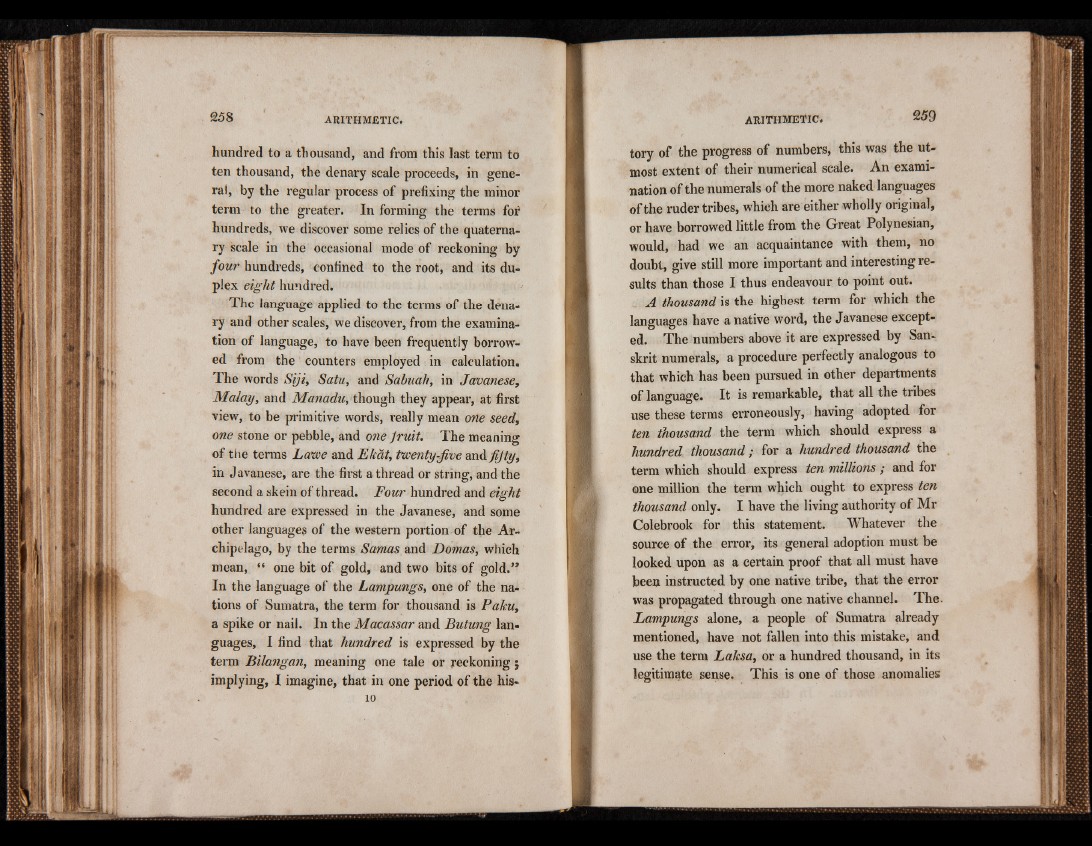
hundred to a thousand, and from this last term to
ten thousand, the denary scale proceeds, in general,
by the regular process of prefixing the minor
term to the greater. In forming the terms foi
hundreds, we discover some relics of the quaternary
scale in the occasional mode of reckoning by
four hundreds, confined to the root, and its duplex
eight hundred.
The language applied to the terms of the denary
and other scales, we discover, from the examination
of language, to have been frequently borrowed
from the counters employed in calculation.
The words Siji, Satu, and Sabuah, in Javanese,
Malay, and Manadu, though they appear, at first
view, to be primitive words, really mean one seedy
one stone or pebble, and one fruit. The meaning
of the terms Lawe and Ekat, twenty-jive mid fifty,
in Javanese, are the first a thread or string, and the
second a skein of thread. Four hundred and eight
hundred are expressed in the Javanese, and some
other languages of the western portion of the Archipelago,
by the terms Samas and Domas, which
mean, “ one bit of gold, and two bits of gold.”
In the language of the Lampungs, one of the nations
of Sumatra, the term for thousand is Paku,
a spike or nail. In the Macassar and Butung languages,
I find that hundred is expressed by the
term Bilangan, meaning one tale or reckoning j
implying, I imagine, that in one period of the his*
tory of the progress of numbers, this was the utmost
extent of their numerical scale. An examination
of the numerals of the more naked languages
of the ruder tribes, which are either wholly original,
or have borrowed little from the Great Polynesian,
would, had we an acquaintance with them, no
doubt, give still more important and interesting results
than those I thus endeavour to point out.
A thousand is the highest term for which the
languages have a native word, the Javanese excepted.
The numbers above it are expressed by Sanskrit
numerals, a procedure perfectly analogous to
that which has been pursued in other departments
of language. It is remarkable, that all the tribes
use these terms erroneously, having adopted for
ten thousand the term which should express a
hundred thousand; for a hundred thousand the
term which should express ten millions ; and for
one million the term which ought to express ten
thousand only. I have the living authority of Mr
Colebrook for this statement. Whatever the
source of the error, its general adoption must be
looked upon as a certain proof that all must have
been instructed by one native tribe, that the error
was propagated through one native channel. The.
Lampungs alone, a people of Sumatra already
mentioned, have not fallen into this mistake, and
use the term Laksa, or a hundred thousand, in its
legitimate sense. This is one of those anomalies